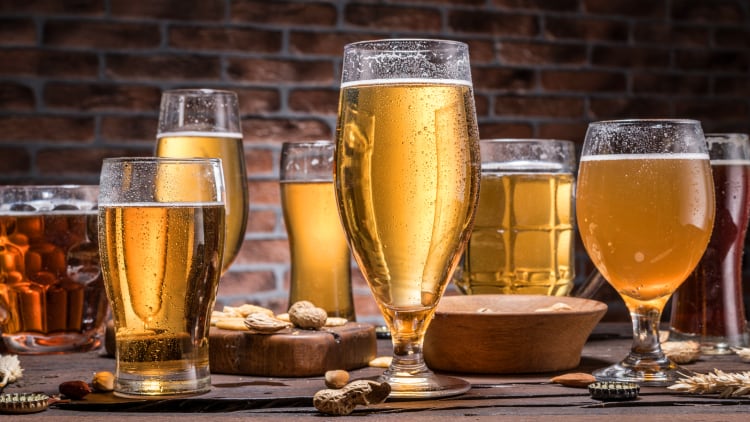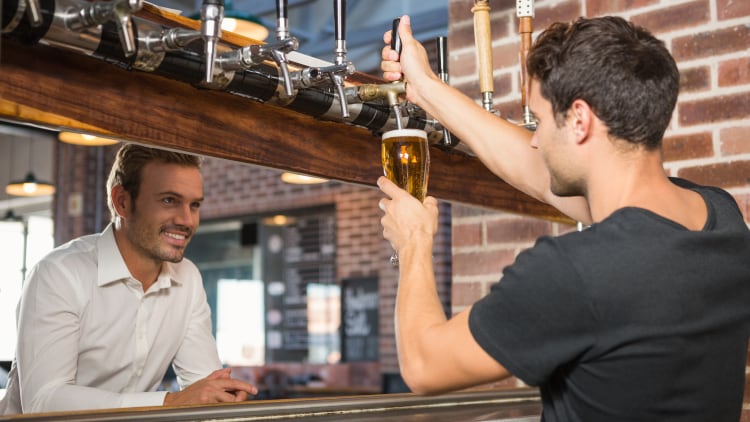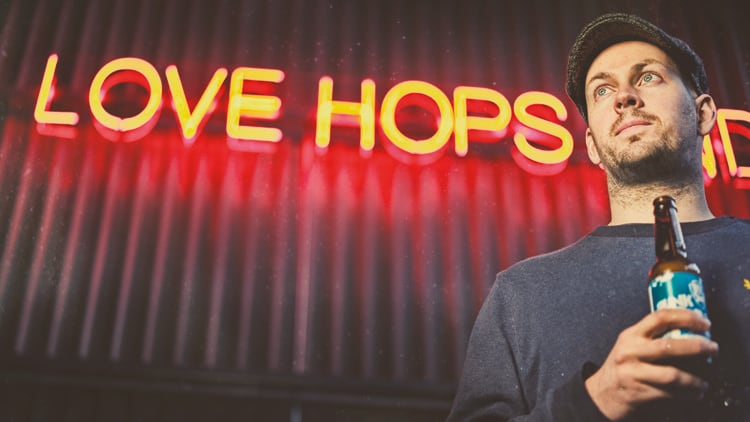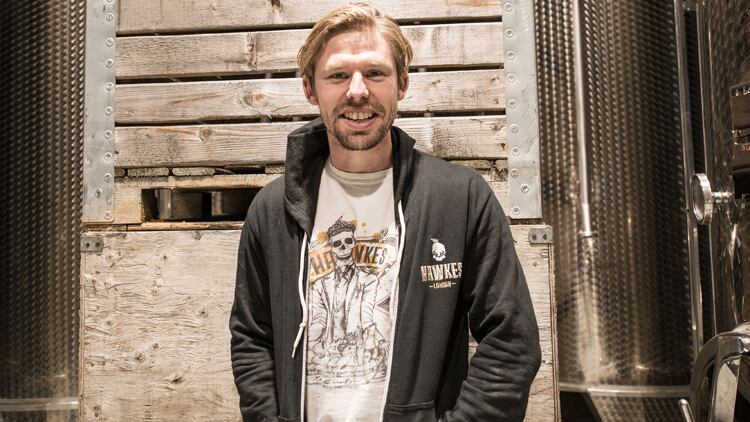Pubs are constantly hit with a plethora of headwinds, one of which is ever-rising beer prices. According to the Office of National Statistics (ONS), in May 2009, the average cost of a pint of lager was £2.81 and as of March 2019, the price is £3.67. This is a difference of 86p and in percentage terms, is an increase of just over 30%.
During the past decade, the biggest incremental increase was from May 2009 to May 2010 – a rise of 14p, equating to 5%. e smallest rise has been from May 2018 to May 2019 where the price rose by just 3p – a percentage increase of less than 1%.
However, Brits are still unhappy with the cost of a pint of beer. In May 2018, YouGov conducted a survey where it discovered the average price of a pint of beer in Britain was 60p more than Brits thought was reasonable.
The study included more than 40,000 respondents who were asked what they thought was a reasonable price for a pint at the pub and compared the answers with the average price of pints across the country.
It found the national average ‘reasonable’ price for a pint, as perceived by Brits, was £3, which was 60p lower than the national average cost of a pint at the time – 67p lower than the average pint of lager cost recorded by the ONS in May 2019.
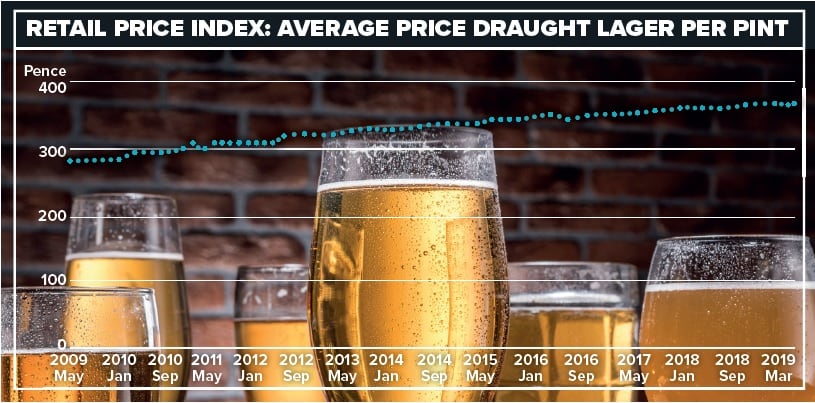
The perfect pint
A similar study commissioned by St Austell Brewery’s Proper Job IPA found four in 10 Brits, who drink beer, were unhappy about the cost of a pint.
The research, which involved 2,000 respondents, also delved into what drinkers think makes a perfect pint and found the brew should have a head of 9mm, served in a ‘proper’ pint glass at 5.30pm on a Saturday, in a beer garden with a partner, the study revealed.
It claimed the ideal pint should be partnered with a packet of crisps, a good catch-up with a partner and with mobile phones out of sight.

The perfect location was a country pub with a beer garden and should take precisely 28 minutes to drink. During the same month, Money Guru revealed the most expensive pint in the UK was in London and was £5.19, followed by Oxford at £4.57, Edinburgh’s average cost of a pint was £4.35, Bristol was in fourth place at £4.32 and Winchester was ‑ fifth most expensive at £4.30. This means a beer in London was more than double (55%) the price of a beer in Carlisle.
When it came to the cheapest pints, Carlisle topped the list with the average price at £2.35 – £1.32 less than the current cost of a price of lager – followed by Chelmsford in Essex at £2.60. In third place was Newport, south Wales, at £2.75, Armagh in Northern Ireland was £2.78 and in joint fth place was Salisbury in Wiltshire, Lancaster and Newry in Northern Ireland, all with an average pint cost of £2.80.
On the subject of pricing, CGA data showed that across amber, dark and golden, the price of a pint of cask was £3.39, £3.33 and £3.46 respectively, in the Cask Report 2018-2019.
However, these types of cask were cheaper than craft beers in keg format, which were priced at £5.16, £4.92 and £4.65 for the three styles.
Craft keg saw a rise over the year to September 2018 with an average across the three styles of 5.3% whereas traditional cask price has risen by 2.4% in the previous 12 months.
Traditional ‘mainstream’ lager saw a notable rise, according to the report, as it increased by 9.4% to £3.96 a pint. The average cost of a pint of mainstream lager of £3.96 put it at a higher level than the price of cask ale throughout the nation. Cask ranges from the lowest price of £2.94 in Wales to £3.82 in London.
Climate issues
In October 2018, The Morning Advertiser reported severe changes in the climate could mean a beer shortage, resulting in higher prices.
The study, involving the University of East Anglia (UEA), warned that increasingly widespread and severe drought and heat may cause “substantial decreases in barley yields worldwide”, which would impact the supply used to make beer and, ultimately, result in “dramatic” rises in beer prices and falls in beer consumption.
It revealed that in the UK, beer consumption could drop by between 370m and 1.33bn litres, while the price could as much as double. Consumption in the US could fall by between 1.08bn and 3.48bn litres.
Changes in the price of beer in a country related to consumers’ ability and willingness to pay more for beer rather than consume less, such that the largest prices increases are concentrated in relatively affluent and historically beer-loving countries.
A spokesperson for the Campaign for Real Ale said: “The latest statistics released by the ONS reflects a worrying trend for pubgoers across the country.
“As the price of a pint continues to climb, consuming alcohol at home has become a cheap alternative. When this happens, everyone suffers – the trade, the individual and the community as a whole.
“Pubs are the natural home for the beer consumer and the ideal place for responsible drinking – they help being local communities together, tackle loneliness and provide a vital support network for people in need.
“It is imperative they continue to stay open and thriving, and people can continue to drink responsibly in them.
“That is why we are calling on the Government to tackle the huge tax burden pubs face to help keep prices down and, ultimately, ensure the future survival of British pubs.”
UKHospitality chief executive Kate Nicholls emphasised the issue of rising prices overall across the trade.
She said: “Costs continue to increase for businesses, so it is no wonder that the average price of a pint continues to climb. Even with the scrapping of the beer duty escalator, many businesses have no choice but to pass costs on to customers.
“Venues are being hit by continually increasing property costs alongside instability caused by Brexit. The Government can support businesses by fixing the broken business rates system and committing to a VAT reduction for hospitality. Only by significantly lowering costs will customers be likely to see a drop in prices.”
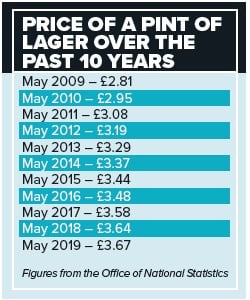
Reasons for rising prices
British Beer and Pub Association chief executive Brigid Simmonds outlined the reasons behind the price of beer rising over the past decade.
She said: “The price of a pint has risen over the past 10 years for many reasons; ranging from high taxes to growing inflationary pressures for both brewers and publicans alike. The beer duty escalator alone saw beer tax rise by 42%, putting up the price of a pint and causing beer sales to fall by 24% in the on-trade.
“More recent cuts and freezes to beer duty, as well as business rates support, have helped the market to stabilise. The fact remains though that as so many pubs are small businesses, it is no surprise that the combination of rising costs and taxes forces them to put up their prices.”
However, from a brewer’s point of view, the price of lager reflects the time and effort that has gone into making it.
The Society of Independent Brewers head of PR and marketing Neil Walker said: “Like most alcoholic drinks, the price of a pint of lager has slowly increased over time but what has been interesting in recent years is the consumer shift from mass-produced, low flavoured lagers from the global beer companies to quality independent beers from craft brewers.
“Many people are drinking less for various reasons, including price, and are choosing quality over quantity. If you are spending more on average for a pint, then choosing a quality locally brewed beer is surely the way to get the best value for money, never mind the best flavour and freshness.”
While the cost of the price of beer is increasing and the amount it has risen has been volatile over the past 10 years, the trade should encourage the Government to keep headwinds such as beer duty and tax increases as low as possible in a bid to keep pubs going.

